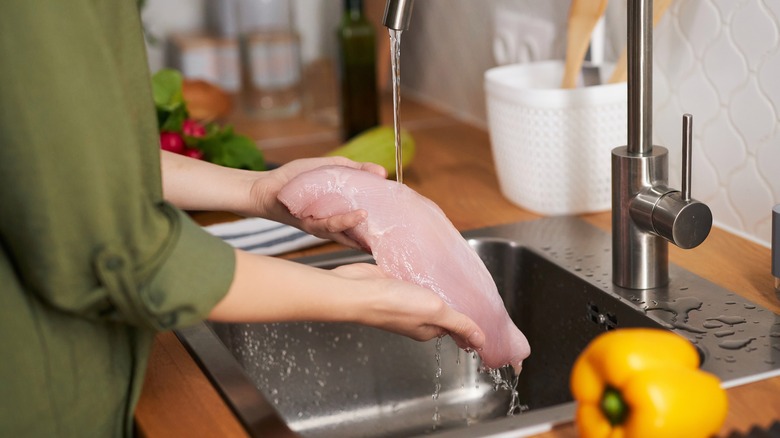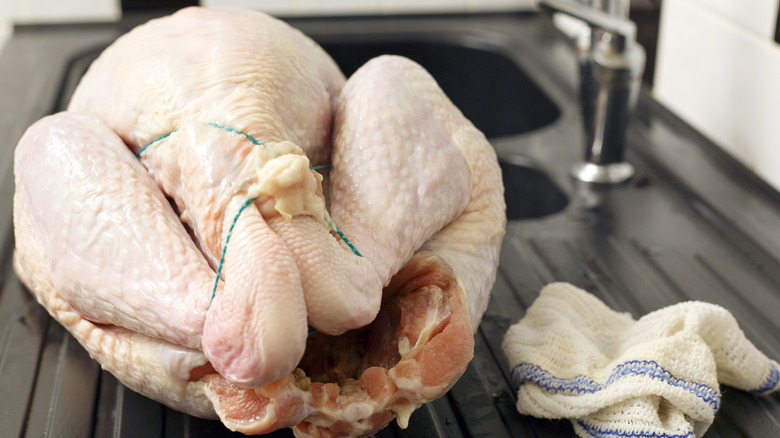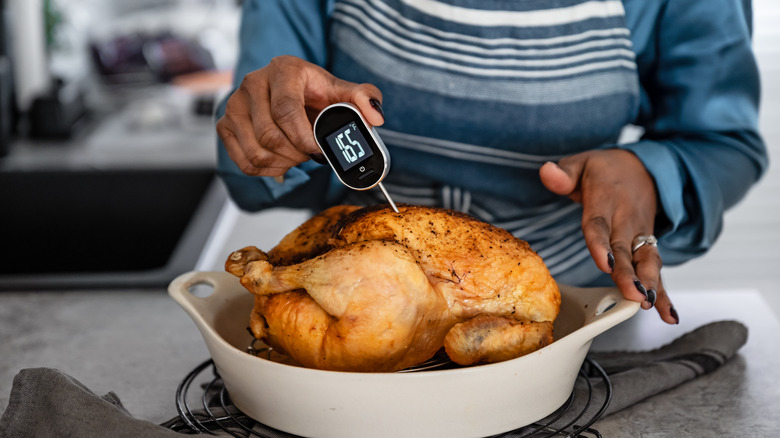Why You Should Never Wash Chicken Before Cooking It
Pineapple on pizza, the correct way to cut sandwiches, how to properly load the dishwasher – many debates get foodies riled up, but none like whether or not raw chicken should be washed. On one hand, the surface of chicken is slimy and could be harboring all manner of unsavory things, from slime to salmonella, but on the other hand, some say that this step is unnecessary and that proper cooking will do the job. If you're a person who washes chicken, we're sorry to inform you, but the latter group is right.
Yep — just like you shouldn't wash store-bought eggs in the U.S., you shouldn't wash raw chicken. In short, it's not the most effective way to kill germs, and could even spread them around your kitchen. Despite this risk, many people are adamant about washing their chicken, sometimes because a family member always did. It's a tradition passed down through generations, likely originating when people raised and butchered chickens at home, which made washing meat a common practice. However, if you're buying chicken from the grocery store today, some expert-backed methods can keep you safe from germs.
What happens when you wash chicken
When chicken (or other meat) is rinsed, bacteria have more chances to spread. It can coat your hands and the surfaces they touch, drip into the sink, and splatter on surrounding surfaces. Even if you sanitize the areas you think the chicken touched, you will most likely miss some spots, which could lead to cross-contamination. A USDA study corroborated this assumption by observing participants washing chicken and then making a salad. The group who washed the chicken contaminated around 25% of their salads and 14% of their sinks, even after sanitizing.
It turns out that washing chicken doesn't eliminate as many germs as you'd think. Bacteria gets on your hands and can be spread around the chicken, and if you let the chicken touch your sink, it could pick up even more bacteria. According to Eileen Abruzzo, an infection control expert who spoke with WebMD, your kitchen sink can harbor more bacteria than your toilet seat. This is a big deal because one million people in the US contract food poisoning yearly from contaminated poultry like chicken, which can harbor Salmonella, Campylobacter pylori, and Clostridium perfringens bacteria.
How to make sure your chicken is safe to eat
Preventing cross-contamination begins at the grocery store. Put store-bought chicken in a disposable bag so that any drips don't contaminate your other groceries. At home, keep raw chicken in a sealed container to prevent it from touching other food. Lastly, check that your fridge is at the proper temperature (40 degrees Fahrenheit or below) to prevent bacteria from proliferating.
After handling raw chicken, the Center for Disease Control (CDC) recommends washing your hands with soapy water for 20 seconds and sanitizing countertops using hot, soapy water followed by a disinfectant. When it comes time to prepare the chicken, blot it dry and use a separate cutting board to trim and season it. When brining poultry like turkey, clean up drips before refrigerating, carefully remove the poultry after brining, pour out the brine, and then rinse off the poultry gently to prevent splashes. Afterward, sanitize every part of the sink, including the faucet and nearby countertops.
Chicken should then be cooked to an internal temperature of 165 degrees Fahrenheit (high enough to kill bacteria in or on it). After serving, refrigerate the leftover cooked chicken within one to two hours, then either eat chilled (like on a chicken salad) or reheat thoroughly. At the end of the day, even the CDC mentions that the decision to wash your chicken or not is a personal preference, but whichever you choose, be sure to take careful steps to keep your kitchen (and food) safe.


